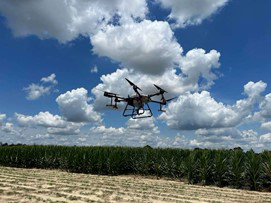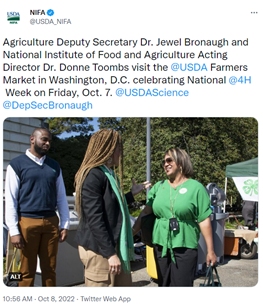
Food and Agriculture Service Learning Program
The purpose of the Food and Agriculture Service Learning Program is to increase the knowledge of agricultural science and improve the nutritional health of children. The program’s goal is to increase the capacity for food, garden and nutrition education within host organizations or entities, such as school cafeterias and classrooms, while fostering higher levels of community engagement between farms and school systems by bringing together stakeholders from distinct parts of the food system. The initiative is part of a broader effort to not only increase access to school meals for low-income children, but also to dramatically improve their quality. Closing date: December 8.
Children choose fruits and vegetables for lunch in a cafeteria, courtesy of Adobe Stock.
|

Specialty Crop Research Initiative
The purpose of the Specialty Crop Research Initiative program is to address the critical needs of the specialty crop industry by awarding grants to support research and Extension that address key challenges of national, regional and multistate importance in sustaining all components of food and agriculture, including conventional and organic food production systems. Closing date: January 12, 2023.
Bags of dried legumes and grains in a market, courtesy of Adobe Stock.
|

Biotechnology Risk Assessment Research Grants Program
The purpose of the Biotechnology Risk Assessment Research Grants Program program is to support the generation of new information that will assist federal regulatory agencies in making science-based decisions about the effects of introducing genetically engineered organisms into the environment. Investigations of effects on both managed and natural environments are relevant. Closing date: January 23, 2023.
A scientist works on a computer, courtesy of Adobe Stock.
|
Pending weather-related events in the Southeast, if your ability to meet a NIFA deadline is impacted, please reach out to your NIFA program contact to let them know so that they can provide support and guidance.
USDA Invests $14M in Hispanic-serving Institutions Education Grants Program
USDA has invested $14 million in 30 projects as part of the Hispanic-serving Institutions Education Grants Program. The Hispanic-Serving Institutions (HSI) Education Grants Program promotes and strengthens the ability of HSIs to carry out higher education programs to attract, retain and graduate outstanding students capable of enhancing the nation's food, agriculture, natural resources, and human sciences professional and scientific work force. This grant program aligns the efforts of HSIs to support academic development and career attainment of underrepresented groups. HSIs are institutions that have at least 25% undergraduate full-time Hispanic enrollment.
FY 2022 Awardees: Arizona Western College, Bronx Community College, California State University-Fresno (3 awards), Colorado State University-Pueblo, Florida International University, New Mexico Highlands University, New Mexico State University (2 awards), Northern Arizona University (3 awards), San Diego State University, Texas A&M University-Kingsville (2 awards), Texas State University, Universidad Ana G. Mendez-Carolina, University of Arizona, University of California-Merced, University of California-Santa Barbara, University of North Texas, University of Puerto Rico-Carolina, University of Puerto Rico-Mayaguez (2 awards), University of Texas Rio Grande Valley, University of Texas at San Antonio (2 awards), Wenatchee Valley College, and Western New Mexico University.
Biotechnology Risk Assessment Research Grants RFA Technical Assistance Webinar
NIFA staff will be holding an RFA technical assistance webinar on October 27 at 3 p.m. CDT to provide more information and answer audience questions about the Biotechnology Risk Assessment Research Grants FY 2023 Request for Applications. This program will invest approximately $5.5 million in projects that generate new information that assist federal regulatory agencies in making science-based decisions about the environmental effects of introducing genetically engineered organisms. Registration required.
NIFA Listening Session for Stakeholder Input to Science Priorities

National 4-H Conference
Mark your calendars for the 2023 National 4-H Conference, being held April 14-19, at the Hyatt Regency Crystal City in Arlington, Virginia, and online. NIFA offers a variety of leadership positions for 4-Hers to participate in the conference, including as Collegiate Facilitators and Youth Leadership Team members. Visit our website to download job descriptions and applications.
NIFA 2023 National 4-H Conference Save the Date graphic.
|

Food Safety on the Farm
More than ever, consumers are going to the source for their food. In 2020, farmers produced and sold $9 billion of local edible food commodities directly to consumers, retailers, institutions and intermediaries. With direct sales growing, strengthening the nation’s food safety system to prevent foodborne illness is crucial. NIFA supports wide-ranging efforts to provide farmers with the tools they need to ensure a safe and sustainable food supply as well as research into innovative technologies to reduce foodborne pathogens and to improve food safety processes beginning at the farm level.
National Farmers Day NIFA graphic.
Read about the impacts of NIFA-funded research and Extension programs on our blogs page.
|

Internal NIFA Working Group Launched to Recommend New NIFA Grants Management System
The Quality Services Management Office (QSMO) Business Enterprise Team (BET) will lead the effort to identify a new end-to-end grants management system to replace two of NIFA’s systems: CREEMS and ezFedGrants. The primary work of the BET is to review, analyze and recommend a single solution as NIFA’s grants management system service provider. The group will consider the two available QSMO solutions for grants management: GrantSolutions from the Department of Health and Human Services and eRA from National Institutes of Health. QSMOs are designated by the Office of Management and Budget as governmentwide storefronts for technology and services solutions. Read background information on QSMOs.
Grants regulator graphic, courtesy of Adobe Stock.
|

Research Uncovers Two Pathways to Herbicide Resistance in Weedy Rice
Researchers at the University of Arkansas (UA) and Missouri’s Washington University have confirmed two genetic pathways that lead to herbicide resistance in weedy rice, a major pest for Arkansas rice growers. Weedy rice is a major problem in Arkansas, which produces nearly half the rice grown in the United States. In 2020, rice contributed more than $1.1 billion to the state’s agricultural economy. Weedy rice infestations cause an estimated $45 million in economic losses in the U.S. each year from yield losses and reduced grain quality.
Nilda Burgos, professor of weed physiology and molecular biology, was co-author of a research paper describing two genetic pathways to acetolactate synthase herbicide resistance in weedy rice. Photo courtesy of Fred Miller UA System Division of Agriculture.
|

Adding Fungal Enzymes to Dairy Cow Rations Boosts Milk Output and Quality
Supplementing the feed of dairy cattle with enzymes from two fungi simultaneously has a positive effect on the animals’ lactational performance, according to Penn State researchers, who studied the concept in an experiment with cows.
Holstein dairy cows, courtesy of Penn State.
|

University of Georgia Extension Investigates Potential of Spray Drones in Agriculture
It’s a familiar sight for many — a ground sprayer slowly making rounds in a field, applying pesticides to row crops to give producers the best chance of protecting crops from pests and seeing high yields at harvest. But there are times when these large, heavy ground sprayers have limitations. But according to University of Georgia Extension, there may be an alternative in coming years: sprayer drones.
When properly programmed and operated, sprayer drones are able to fly above crops to apply chemicals using a small tank and spray nozzles, avoiding muddy fields and difficult terrain, all while providing the targeted application that saves growers money and time. Photo courtesy of Simer Virk University of Georgia.
|

Census of Agriculture Coming This November
Check your mailbox: USDA will mail the 2022 Census of Agriculture to millions of agriculture producers across the 50 United State and Puerto Rico this fall. Changes to the 2022 questionnaire include new questions about the use of precision agriculture, hemp production, hair sheep, and updates to internet access questions.
Ag Census Counts graphic, courtesy of NASS.
|

Agriculture Deputy Secretary Dr. Jewel Bronaugh and National Institute of Food and Agriculture Acting Director Dr. Dionne Toombs visit the USDA Farmers Market in Washington, D.C. celebrating National 4-H Week on Friday, Oct. 7.
|
|